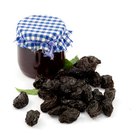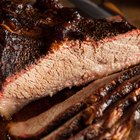
Cooking bags are good for everything from cooking a few cups of corn for your family to roasting an entire turkey. The heat-safe bags are available in a variety of sizes and are useful for steaming food in the microwave or roasting in the oven. Both steamer bags and oven bags work by trapping steam and heat to surround the food with hot, moist air. The result is a moist, delicious meal and potentially less time spent in the kitchen.
Steamer Bags
Steamer bags, sometimes called steaming bags or steam cooking bags, are plastic cooking bags that are designed for use in your microwave. They are specially vented to prevent excess buildup of pressure or steam, but they shorten cooking time by enclosing the meat or vegetables in a small space and using the food's own moisture to cook it by bathing it in steam. The cooking times will vary according to how much meat or vegetables you are putting in, as well as what you are cooking. A bag with 4 cups of corn, for example, takes five minutes to steam in a typical microwave, which is less time than it would take to boil water and steam the food conventionally.
Using Steamer Bags
Fill the bag with your frozen meat or vegetables and seal the bag. Most steamer bags hold up to 4 cups of meat or vegetables. The less you fill the bag, the faster the meat or vegetables will cook. Do not fill the bag past the fill line or the steam will not have a chance to cook the food adequately because it will not have enough room to circulate. Don't overcook the food or it may become gummy or even dry out in the steamer bag.
Oven Bags
Oven bags are similar to steamer bags, except they are much larger and don't come with pre-made vents. These bags are designed to cook large roasts or entire birds, such as a turkey. They reduce cooking time by enclosing the roast or bird and trapping moisture, which steams the meat as it braises in the moisture. Because they trap moisture, oven bags also help the meat retain more of its juices. The amount of time saved by using an oven bag varies by what you are cooking, but it can save up to one hour on cooking a turkey.
Using Oven Bags
Add a tablespoon of flour to the oven bag and shake the bag to distribute it. The flour prevents the bag from sticking to itself as the meat cooks. Place the meat in the bag, along with any stock or cooking liquid. Tie the bag closed with the tie that came with the bag, and cut 1-inch slits in the top of the bag to allow some of the steam to escape. When you take the temperature of the roast of the bird, insert the meat thermometer right through the plastic, rather than opening the bag, to avoid being burned by steam.
Related Articles

Is It Safe to Cook Vegetables in ...

How to Cook a Roast in a Bag

How to Steam Clean Clothes
How to Cook Prime Rib Roast in a ...

How to Cook Meat Loaf in an Oven Bag
How to Cook a Brisket in a Bag

How to Cook a Roast With the Flavorwave

How to Roast a Whole Chicken in a ...

How to Make Pot Roast in a Cooking Bag
How to Cook Chuck Roast in a Baking Bag

Baking Pork Tenderloin, Potatoes & ...

Calories in a Bag of Chocolate Chips

How to Use Reynolds Oven Bags

How to Clean an Oven Liner
Difference Between Cooking in a Regular ...

How to Clean a Leather Hobo Bag

How to Can Jelly Using a Pressure Canner

How to Use a Bamboo Steamer

How to Steam a Brisket of Beef

What Is the Difference Between a ...
References
Writer Bio
Natalie Smith is a technical writing professor specializing in medical writing localization and food writing. Her work has been published in technical journals, on several prominent cooking and nutrition websites, as well as books and conference proceedings. Smith has won two international research awards for her scholarship in intercultural medical writing, and holds a PhD in technical communication and rhetoric.
Photo Credits
Brand X Pictures/Brand X Pictures/Getty Images